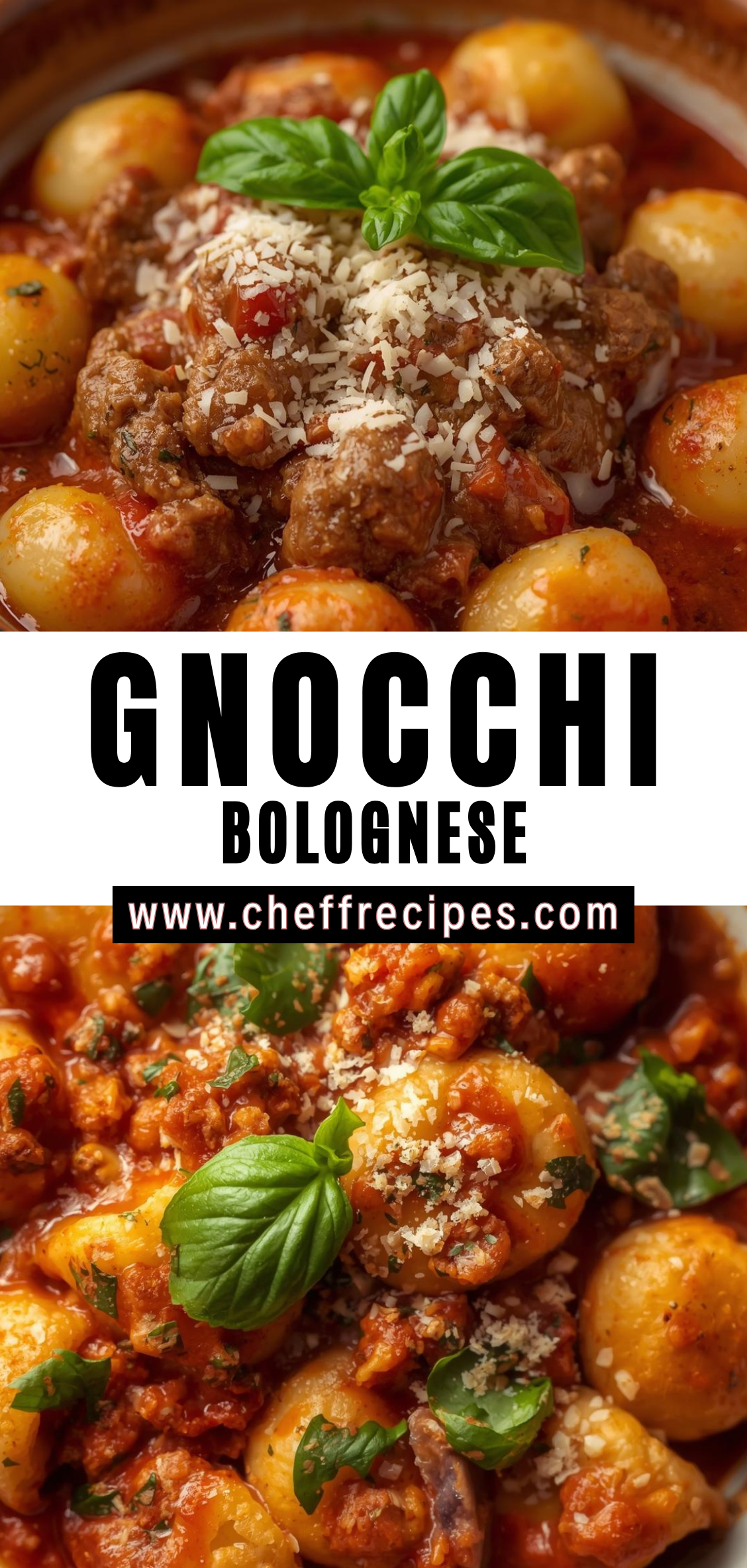Italian cuisine stands as one of the most celebrated culinary traditions in the world, known for its remarkable balance of simplicity and sophistication. Within this vast gastronomic landscape, few dishes encapsulate the heart of Italian comfort food as vividly as Gnocchi Bolognese. A seemingly humble pairing of soft, pillowy potato dumplings and a slow-simmered meat sauce, the dish carries with it centuries of regional history, cultural identity, and culinary evolution. Though at first glance it might appear to be a simple pasta-and-sauce combination, Gnocchi Bolognese represents a confluence of Italy’s agricultural heritage, regional distinctions, and the enduring philosophy that food is a vessel for community and storytelling.

The origins of gnocchi trace back to ancient times, long before the introduction of the potato to Europe. Early forms were made from semolina, breadcrumbs, or flour, bound together with eggs or cheese to create small dumplings that could absorb rich sauces or broths. It was only after the 16th century, following the arrival of the potato from the Americas, that the modern version of potato gnocchi began to emerge. This transformation marked a significant evolution in Italian cuisine, blending indigenous techniques with global influences to create something unmistakably Italian yet globally inspired. Over time, gnocchi became a staple in home kitchens across the peninsula, beloved for its comforting texture and its ability to pair harmoniously with a variety of sauces.
The Bolognese component, on the other hand, finds its roots in the northern city of Bologna, situated in the Emilia-Romagna region—a place often heralded as the gastronomic heart of Italy. Ragù alla Bolognese, as it is traditionally known, is far more than a simple meat sauce. It is a meticulously layered preparation that speaks to the Italian respect for patience, quality ingredients, and regional specificity. Contrary to the globalized notion of “spaghetti Bolognese,” the authentic ragù is a slow-cooked blend of finely minced meat, soffritto (a base of onion, carrot, and celery), wine, milk, and tomatoes, simmered together to achieve a deep, mellow complexity. Each ingredient contributes to a carefully balanced sauce that embodies the culinary ethos of Emilia-Romagna: a respect for craft, a focus on flavor development, and an appreciation for tradition.
When gnocchi and Bolognese are combined, they form a dish that transcends its ingredients. The soft, yielding dumplings absorb the rich, savory ragù, creating a textural and aromatic harmony that exemplifies Italian comfort food at its most profound. Yet beyond its sensory appeal, Gnocchi Bolognese carries with it cultural and symbolic weight. It embodies the Italian philosophy of cucina povera—the art of creating nourishment and joy from simple, accessible ingredients—while also representing the evolution of regional dishes into globally recognized icons. In contemporary contexts, Gnocchi Bolognese bridges the gap between rustic authenticity and modern culinary artistry, appearing both in family kitchens and high-end restaurants around the world.
This essay explores Gnocchi Bolognese not merely as a recipe, but as a reflection of Italy’s culinary heritage, social fabric, and evolving relationship with food. It will examine the historical origins of gnocchi and ragù alla Bolognese, analyze the regional variations and cultural influences that shaped their development, and investigate how the dish has been adapted in global contexts. Furthermore, it will consider the symbolic meanings embedded in this combination—the representation of home, identity, and continuity through food—and the ways in which Gnocchi Bolognese continues to evolve in the face of globalization and contemporary dining trends. By delving into its history, preparation, and cultural resonance, this essay seeks to illuminate how one dish can encapsulate the complexity of an entire culinary tradition.
Ultimately, Gnocchi Bolognese stands as a testament to the enduring relevance of Italian cooking. It reminds us that even in an era of culinary experimentation and fusion, the deepest satisfaction often lies in simplicity—the combination of carefully chosen ingredients, patient technique, and a respect for tradition. As this exploration will show, every plate of Gnocchi Bolognese tells a story of history, adaptation, and the universal human desire for comfort through food.
Overall Essay Structure
1. Introduction
(Already written above.)
2. Historical Background of Gnocchi and Bolognese Sauce
-
Ancient origins of dumplings in Europe and the Mediterranean
-
Early Italian gnocchi (pre-potato versions)
-
Introduction of potatoes to Europe (Columbian Exchange)
-
Evolution of potato gnocchi
-
Origins and evolution of ragù (meat sauce)
-
Bologna’s culinary heritage and codification of Ragù alla Bolognese
-
The cultural intersection that led to combining gnocchi with Bolognese sauce
3. Ingredients and Techniques
-
Importance of ingredient selection (potatoes, flour, meat, vegetables, wine)
-
Technique in gnocchi making (kneading, shaping, boiling)
-
The art of slow-cooked ragù (soffritto, simmering process, texture control)
-
Regional ingredient variations and modern substitutions
4. Regional and Cultural Variations
-
How different Italian regions reinterpret the dish
-
Comparison with similar dishes (e.g., gnocchi with other sauces, polenta with ragù)
-
Italian diaspora and adaptation abroad (e.g., Argentina, North America)
5. Symbolism, Identity, and Cultural Meaning
-
Gnocchi as “home food” and the emotional significance of pasta dishes
-
Bolognese as a symbol of Italian culinary pride
-
Family traditions and intergenerational transmission of recipes
-
The dish as an emblem of cucina povera (poor kitchen) and resourcefulness
6. Modern Interpretations and Global Influence
-
Reinvention in modern restaurants
-
Vegetarian, vegan, and gluten-free adaptations
-
Influence of globalization and culinary fusion
-
Role in fine dining and media representation (cookbooks, TV, social media)
7. Conclusion
-
Summary of cultural, historical, and culinary significance
-
Reflection on how Gnocchi Bolognese embodies Italian values of simplicity, care, and craftsmanship
-
Closing thoughts on food as cultural memory
Now, here’s the next section in full:
Historical Background of Gnocchi and Bolognese Sauce
The story of Gnocchi Bolognese begins long before the dish itself came into being. Its roots lie in two separate culinary traditions that evolved over centuries—the making of gnocchi, small dumplings of varied composition, and the slow-cooked meat sauces that came to define northern Italian cuisine. Each developed under unique geographic, agricultural, and cultural conditions, yet both embody the same principle that defines Italian cooking: transforming humble ingredients into something deeply satisfying and enduring.
Early Forms of Gnocchi
Long before the introduction of the potato, Italians were crafting dumpling-like preparations using ingredients that reflected their regional environments. In ancient Roman times, culinary texts such as Apicius describe preparations resembling gnocchi made from semolina dough mixed with eggs and cheese, shaped into small morsels, and boiled or baked. These early versions were closer to the modern gnocchi alla Romana, a baked semolina dish still popular in central Italy. Such recipes highlight the longstanding Italian fascination with texture and simplicity—turning grains and dairy into nourishing, bite-sized portions that could be easily adapted to different sauces or seasonings.
As Italian regional cuisines diversified through the Middle Ages, variations of gnocchi proliferated across the peninsula. In the north, where wheat was less common, cooks relied on alternatives such as chestnut flour, breadcrumbs, or ricotta cheese. These early dumplings were labor-intensive but highly adaptable, providing sustenance during times when access to fresh pasta or bread was limited. What unified these early versions was not their specific ingredients but the underlying idea: a soft, malleable dough that could absorb flavor and provide comfort.
The Arrival of the Potato
The introduction of the potato to Europe in the late sixteenth century marked a turning point in the evolution of gnocchi. Brought from the Americas as part of the Columbian Exchange, the potato initially met with suspicion across much of Europe. It was considered strange, even dangerous, and took centuries to become widely accepted as a staple crop. However, in northern Italy—especially in regions such as Lombardy, Piedmont, and Veneto—the potato eventually found fertile ground, both literally and figuratively. By the eighteenth century, potato-based gnocchi had begun to appear in local cookbooks, celebrated for their lightness and delicate texture.
The potato transformed gnocchi from a dish of resourceful necessity into a symbol of rustic comfort. Unlike dense, flour-heavy dumplings, potato gnocchi offered a tender bite that complemented a wide range of sauces, from butter and sage to hearty meat ragùs. This transformation illustrates the adaptability of Italian cuisine—its ability to absorb new ingredients without losing its essential character. By the nineteenth century, potato gnocchi had become a beloved feature of northern Italian home cooking, passed down through families and prepared for festive occasions.
The Emergence of Ragù alla Bolognese
While the gnocchi was evolving into its modern form, another culinary masterpiece was taking shape in the city of Bologna. Situated in the fertile Emilia-Romagna region, Bologna has long been known as La Grassa—“the Fat One”—for its abundance of rich and indulgent foods. Here, the concept of ragù, a slow-cooked meat sauce, developed as part of a broader tradition of turning modest cuts of meat into deeply flavorful dishes through time and care.
The earliest recorded reference to a Bolognese-style ragù dates back to the late eighteenth century, though meat sauces had existed in various forms for centuries. The defining characteristic of the Bolognese version was its balance of meat and aromatic vegetables, its use of milk or cream to soften the acidity of wine and tomatoes, and its emphasis on slow, gentle cooking. Unlike the tomato-heavy sauces popularized abroad, traditional ragù alla Bolognese uses only a small amount of tomato paste or puree, focusing instead on the savory depth of the meat itself.
In 1982, the Accademia Italiana della Cucina formally codified the official recipe for ragù alla Bolognese, establishing a standard that emphasized minced beef, pancetta, onion, carrot, celery, tomato paste, white wine, and milk. This codification reflected Italy’s growing interest in preserving regional culinary identities amid the pressures of modernization and globalization. Yet even within Bologna, variations persisted—some cooks preferred a touch of chicken liver for depth, others used a combination of veal and pork, and many adjusted the ratio of ingredients to match family tradition.
The Convergence of Two Traditions
The pairing of gnocchi with Bolognese sauce represents a natural but relatively modern evolution in Italian home cooking. Traditionally, ragù alla Bolognese was most often served with tagliatelle, a flat egg pasta that originated in Emilia-Romagna. However, as potato gnocchi spread across northern Italy, home cooks began experimenting with the rich meat sauce as a topping, finding that the tender dumplings provided an ideal canvas for the complex flavors of the ragù. The result was a dish that combined two quintessential Italian sensibilities: the rustic warmth of peasant cooking and the refined richness of regional gastronomy.
By the twentieth century, Gnocchi Bolognese had become a cherished feature of Italian domestic cooking, appearing on Sunday tables and in trattorias throughout the north. It embodied the post-war Italian ideal of abundance achieved through modest means—a dish that was hearty yet refined, comforting yet sophisticated. Today, it continues to serve as a bridge between tradition and innovation, offering a window into how Italian cuisine evolves without losing its roots.
Gnocchi Bolognese
Italian cuisine stands as one of the most celebrated culinary traditions in the world, known for its remarkable balance of simplicity and sophistication. Within this vast gastronomic landscape, few dishes encapsulate the heart of Italian comfort food as vividly as Gnocchi Bolognese. A seemingly humble pairing of soft, pillowy potato dumplings and a slow-simmered meat sauce, the dish carries with it centuries of regional history, cultural identity, and culinary evolution. Though at first glance it might appear to be a simple pasta-and-sauce combination, Gnocchi Bolognese represents a confluence of Italy’s agricultural heritage, regional distinctions, and the enduring philosophy that food is a vessel for community and storytelling.
Ingredients
- For the Bolognese Sauce:
- 2 tbsp olive oil
- 1 small onion, finely chopped
- 1 medium carrot, finely chopped
- 1 celery stalk, finely chopped
- 2 cloves garlic, minced
- 1 lb (450 g) ground beef (or half beef, half pork)
- ½ cup dry red wine (optional, but adds depth)
- 1 can (14 oz / 400 g) crushed tomatoes or tomato passata
- 2 tbsp tomato paste
- 1 cup beef broth (or water)
- 1 tsp dried oregano
- 1 tsp dried basil
- Salt and black pepper, to taste
- ½ cup whole milk or heavy cream (optional, for richness)
- For the Gnocchi:
- 1 lb (450 g) potato gnocchi (store-bought or homemade)
- For Serving:
- Freshly grated Parmesan cheese
- Fresh basil or parsley, chopped (optional)
Instructions
Notes
- Homemade Gnocchi Option: If using homemade potato gnocchi, make sure they’re firm enough to hold their shape in sauce.
- Vegetarian Option: Substitute lentils or finely chopped mushrooms for the meat.
- Wine-Free Version: Skip the wine and use extra broth instead.



